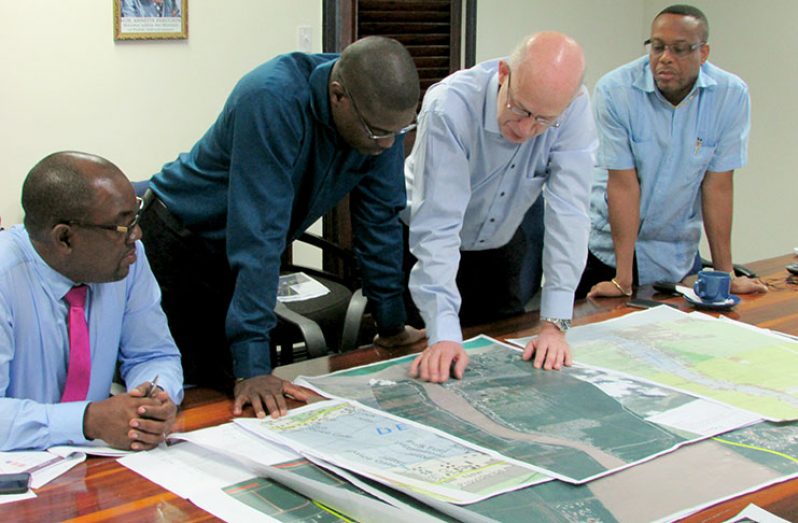Four locations have been identified to site the new Demerara Harbour Bridge with lengths ranging from 580 to 2,000 metres long, the Dutch firm that is conducting a feasibility study into the structure has submitted.
The Demerara Harbour Bridge (a floating bridge) was opened on July 2, 1978 and has a length of the 1851 meters (1.15 miles). The bridge has been under constant maintenance over the years. Minister of Public Infrastructure, David Patterson, along with a team from the Ministry and General Manager of the Demerara Harbour Bridge Corporation, Mr. Rawlston Adams, on Wednesday met with Lievense CSO to discuss the feasibility study for the new Demerara River crossing. Mr. Arie Mol of the Dutch company led a presentation of the concluded first phase of the feasibility study, which commenced on January 15, 2017. The entire feasibility will last six months, and will conclude in July.

In his presentation, Mr. Mol touched on a number of points, including river/marine traffic, river modelling, and economic and environmental considerations. He also highlighted a number of possible locations for the new River Crossing, including New Hope, Peter’s Hall, Eccles, and Houston, with lengths ranging from approximately 580 metres to just under 2,000 metres. A more detailed presentation of the feasibility study is expected to be made at a later date. Additionally, draft reports will be made to Cabinet and then open to consultation by the second week of April.
A pre-feasibility study was done by the Demerara Harbour Bridge Corporation in collaboration with the Ministry of Public Infrastructure in 2013. That study concluded that a new, high level, fixed bridge was the best option to be pursued. The Ministry of Public Infrastructure had advertised for suitable consultants to conduct the feasibility study that would lead to the construction of the bridge through a Public Private Partnership (PPP).
Minister of State, Joseph Harmon had told a news conference last year November that the administration was in no position to state where the bridge was likely to be located but he explained that during the feasibility study, which followed the pre-feasibility done under the People’s Progressive Party Civic (PPPC) administration, a limited area would be considered. “As I did say they have to consider the PPP model, tender documents, look at various sites that would have been in the pre-feasibility and to determine whether in fact this is something we can go forward with. This is the final stage of feasibilities before we get to construction,” he explained.
According to Leivense CSO’s website, the company is an engineering consultancy which specialises in the fields of infrastructure, environment, construction and pipelines. “We specialise in engineering, underground piping, environmental and environment, spatial planning and the built environment. Human activities in densely populated and or sensitive areas bring specific infrastructural and environmental issues along with it,” the company said.
Moreover, the company has more than 200 professionals operating from seven offices in the Netherlands, offices in Saudi Arabia and in St Maarten. “In addition to our Dutch home market we do a lot of projects from abroad, independently or in collaboration with other parties in the Netherlands and abroad. The international focus is in particular ports, water and flood protection, dredging and land reclamation and pipelines.”



.jpg)











